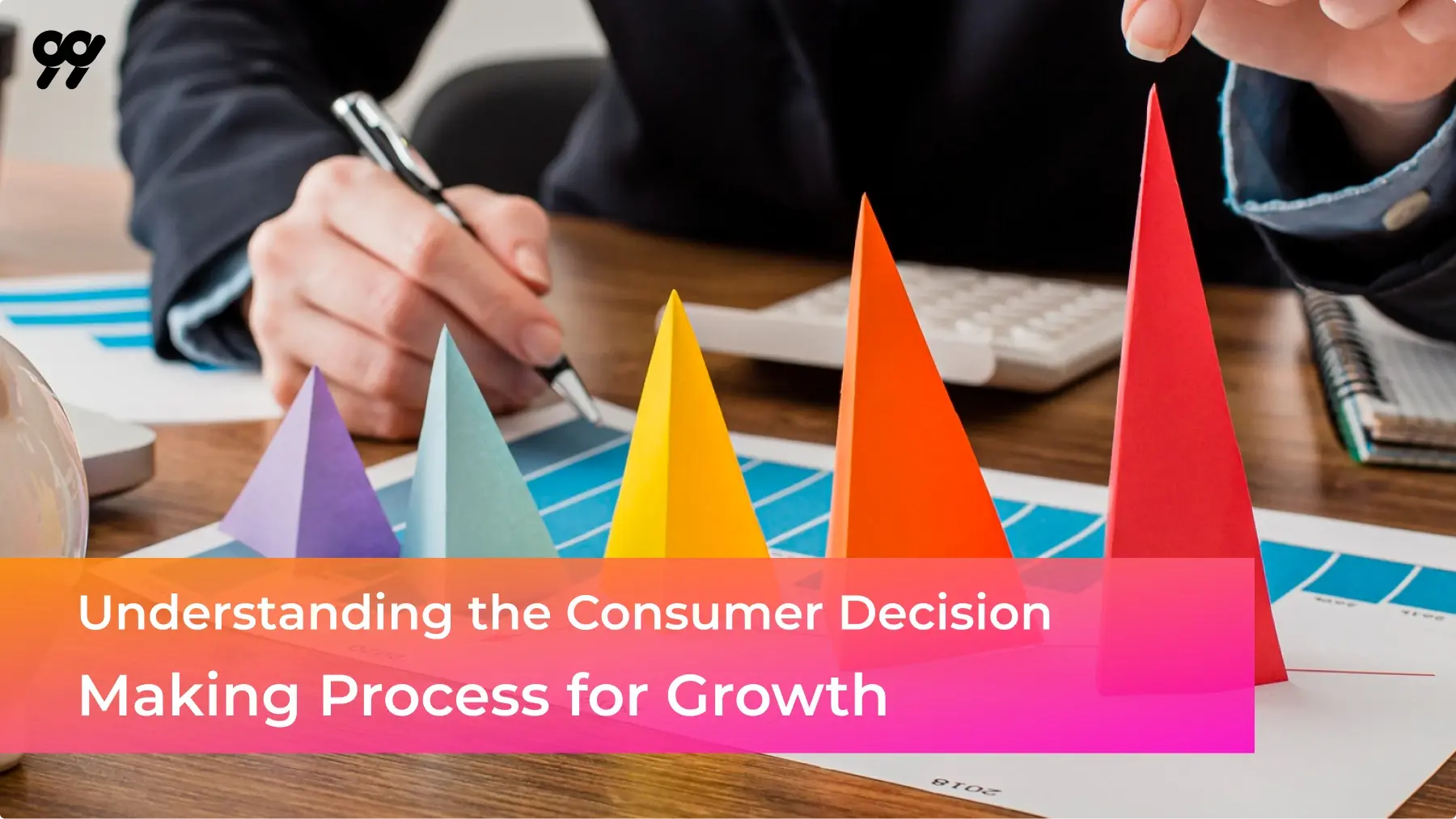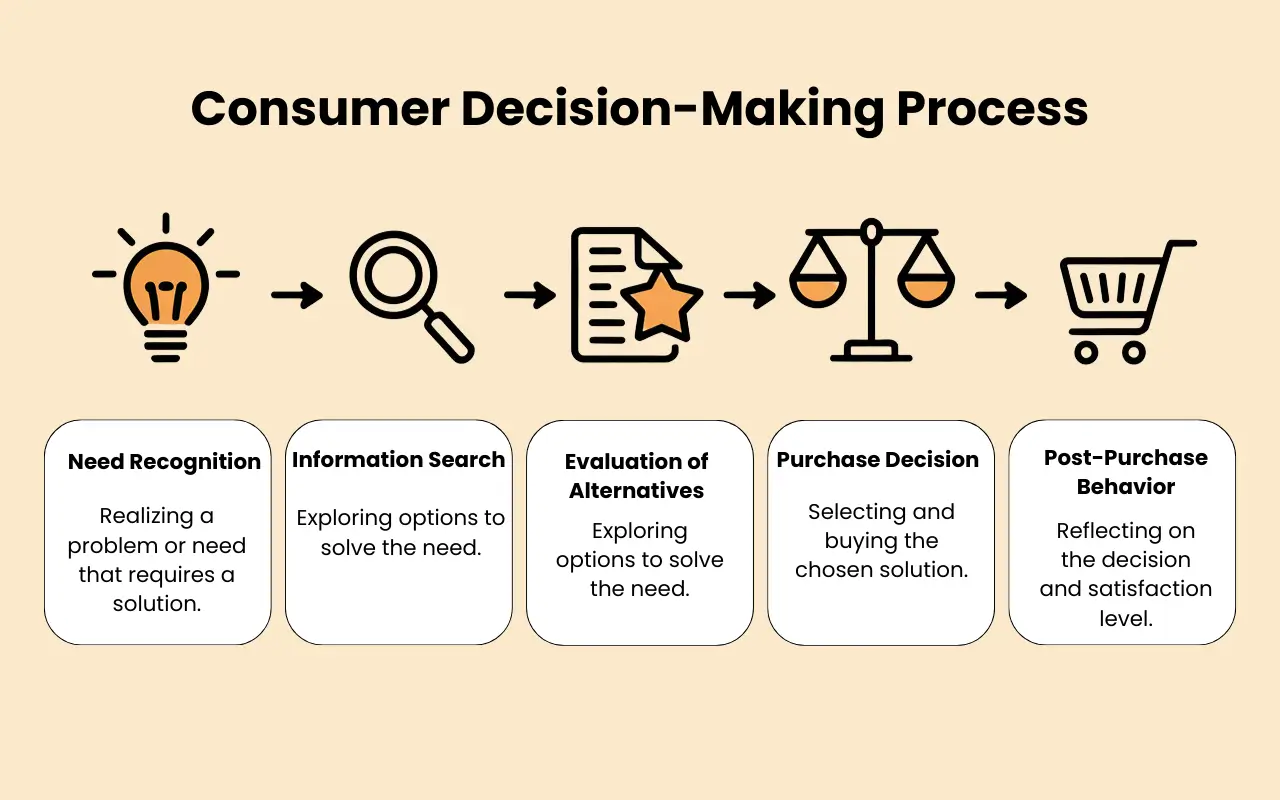
Piyush

The consumer decision-making process is at the core of every successful business strategy. Understanding how your customers decide what to buy and why can unlock the door to business growth.
It isn’t just about what products or services you offer, it’s about understanding your customers’ journey from recognizing a need to making a purchase.
Table of Contents:
The Consumer Decision Making Process describes how customers make choices in a competitive market before, during, and after purchasing. It involves the entire experience, from recognizing a need to evaluating their satisfaction after the purchase.
By understanding this process, businesses can learn what customers want and find ways to address any concerns they might have. This helps create a smoother path to purchase.

Every business needs to understand its customers to succeed. By knowing the buying journey, you can meet customer needs, offer great value, and stand out in the market. Here’s why it’s important:
Understanding the decision-making process enables businesses to improve the customer journey by solving pain points and personalizing experiences. This allows marketers to enhance customer satisfaction at every stage by ensuring smooth navigations, responsive service, and tailored recommendations.
When businesses pay attention to these factors, they can create loyalty and advocacy, thereby transforming happy customers into repeat customers and brand ambassadors.
The insights gained from understanding the consumer decision-making process guide businesses in developing targeted marketing strategies for specific stages. This leads marketers to optimize consumer needs during the awareness, consideration, and purchase process.
By doing so, businesses can engage customers more effectively, showcase the benefits of their products, and utilize tactics like discounts and streamlined checkouts to turn leads into sales.
Knowing the consumer decision-making process helps businesses to identify and overcome obstacles to purchases. Marketers can engage potential buyers by employing strategies such as retargeting ads, live chat support, and testimonials.
By fixing friction points and building trust, businesses can improve conversion rates and close on previously untapped opportunities.
Learning the decision-making process enables businesses to maintain relationships with existing consumers. Marketers can ensure customer satisfaction by addressing to post-purchase concerns and offering ongoing support.
Tailored strategies such as personalized follow-ups, reward programs, and quick responses establish confidence and improve repeat business, resulting in long-term retention and increased customer lifetime value.
Understanding how customers make decisions helps businesses address their doubts and concerns. This builds customer confidence in their choices and fosters trust.
Let’s explore the five key stages of the consumer decision-making process and how businesses can optimize their strategies for each.

All sales begin with a problem or need. This could be as simple as “I’m out of coffee” or as complex as “I need a better software solution for my business.” For businesses, this is the opportunity for them to shine. Get very clear in your marketing materials about what problems your product, service, or thing solves.
For example, consider a person searching for a new smartphone. They might want to replace a broken phone or seek a specific camera feature for creating content. In this case, a business can effectively highlight the smartphone’s features or the quality of its camera to directly meet these needs.
Once the problem is identified, the next stage of the consumer decision-making process is to search for information. Consumers start collecting information about potential solutions. The time for businesses to make their mark is during this phase. Here comes your website, social media & even online reviews.
Imagine someone is shopping for a smartphone. They compare brands, read blogs about the best smartphones for photography, and watch YouTube reviews. Businesses that provide clear product details, side-by-side comparisons, and articles like “Top 5 Smartphones 2025” will succeed in this stage.
Tips to Optimize your Business during this Stage
You can do this by ensuring your site and the pieces of content you publish are optimized against the most relevant keywords your target audience is looking for. Use tooling such as the Google Keyword Planner to find phrases that match their needs. After optimizing your eCommerce storefront, you should now be creating content designed for this stage of the buying journey.
For instance, user-generated reviews and testimonials can add credibility and influence consumers in the research phase. Posts such as “Top 5 Smartphones for Photography in 2025” or video reviews of your product compared to competitors can help you get more thumbs up.
And make sure your website is mobile-friendly too; a large percentage of consumers do research on their phones. Seamless navigation and fast load times can provide a great first impression and reduce the bounce rate of potentially interested buyers.
At this stage of the consumer decision-making process, consumers evaluate alternatives. They’re analyzing the advantages and disadvantages, reading reviews, and possibly even drafting spreadsheets to determine which is in their best interest.
Returning to our smartphone example, the consumer may now have two or three models they are comparing based on things like price, battery life, camera quality, and brand reputation. They will look at user reviews, expert opinions, and even in-store experience.
As a business, your job is to simplify the decision-making process by competitively defining what’s different about your product; extended warranty, exclusive features, after-sales service, etc.
Tips to Optimize your Business during this Stage
Prioritise detailed comparisons between products that highlight your unique offering. This includes making comparison charts to show people why your product is the best choice compared to features, pricing, and benefits.
For instance, a smartphone company may feature a longer battery life, better camera performance, or eco-friendly design in a side-by-side comparison with its competitors. Supplement your claims with real-life case studies or user testimonials for credibility and trust.
Make your website’s product page clear and full of information. Educate customers using video tutorials, 360-degree product views, and FAQs to help overcome common objections. When you give the consumers all the information they could ever want to help them choose between you and your competitors, they will usually choose you.
This is a critical moment. The consumer has decided to buy… or have they? At this stage, even small issues like unexpected shipping fees or a confusing checkout can lead to them abandoning their purchase.
A smooth purchase experience is key for mobile buyers. Businesses can improve this by offering free shipping, discounts for new customers, and flexible payment options. Making the checkout process quick and easy, especially on mobile, can help reduce abandoned carts.
Tips to Optimize your Business during this Stage
First, simplify your checkout process. Keep it clean and straightforward: reduce the number of steps and eliminate distractions. Ensure that it is secure by using multiple payment options, including buy now and pay later.
Clearly show pricing upfront with no hidden fees to build trust and encourage conversions. Display trust badges, such as safe payment certifications, prominently on your checkout page.
You can also use time-limited offers, such as discounts, free shipping, or gifts with purchase, to motivate hesitant buyers to complete their order. Adding personalized recommendations, like related products, during checkout can enhance their shopping experience.
The experience doesn’t end with the purchase. How customers feel after buying will help predict if they will return or recommend your brand. Happy customers come back and tell others, while unhappy ones leave bad reviews.
For instance, if someone loves their new smartphone, they might write a positive review or tell a friend. On the other hand, unclear warranty details or poor support could frustrate them. You can improve customer feelings by sending thank-you emails, providing quick customer support, and giving tips on how to use the product.
You can also set up a loyalty program for repeat purchases. For example, you could offer points for every dollar spent or provide special deals only for members. A smartphone brand might give free accessories, offer discounts on future upgrades, or allow loyal customers to access new product launches first. Lastly, satisfied customers can be your best promoters.
Map the Customer Journey: Identify the steps your customer takes from awareness about your product to deciding to buy it and what happens after the purchase. Map their journey to see their interactions and find ways to exceed their expectations at each stage.
Personalize Customer Interactions: Leverage data-driven insights to provide personalized recommendations, customized promotions, and targeted communication. The more valued and understood the customer feels the more likely they will complete a purchase.
Simplify the Purchase Process: Minimize friction in the buying process by optimizing your website, offering multiple payment options, and ensuring a mobile-friendly experience. A seamless checkout process can significantly reduce cart abandonment rates.
Offer Value Beyond the Purchase: Provide value beyond just selling a product. Offer useful content, loyalty rewards, or an excellent experience after the purchase. These efforts not only improve customer satisfaction but can also encourage repeat customers and referrals.
Continuously Collect and Act on Feedback: Encourage customers to share their feedback and use their insights to improve your products and services. Regularly check customer satisfaction through surveys and address any issues that arise during their experience.
The consumer decision-making process is a journey with several steps and influences. By understanding and caring about each step, your brand can connect better with customers and provide great value.
To succeed in today’s competitive market, regularly review the customer journey, improve your strategies, and adapt to changing consumer behavior. This builds stronger customer relationships and boosts loyalty and sales. If you want to level up your customer journey, book a demo with 99minds. Learn how to create strong customer relationships, sustainable growth, and long-term success.